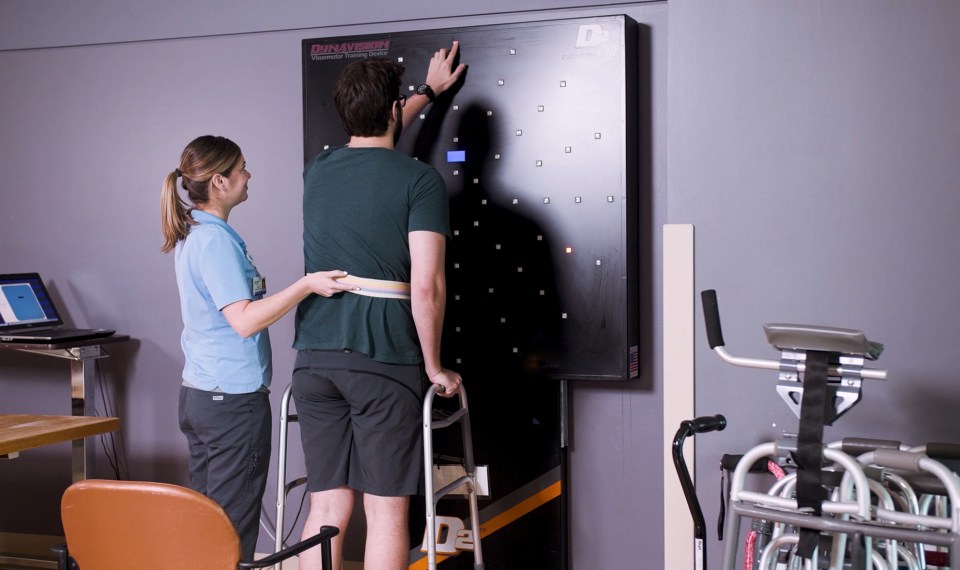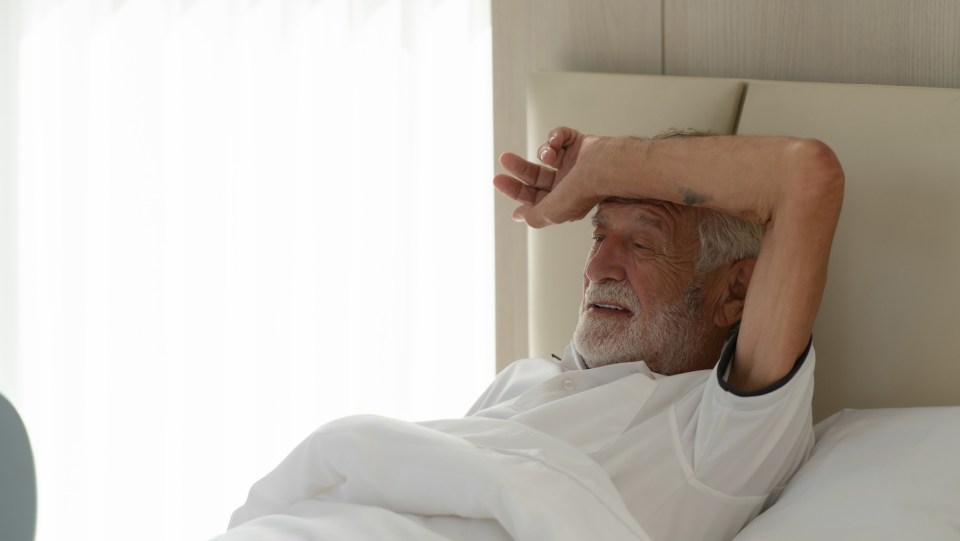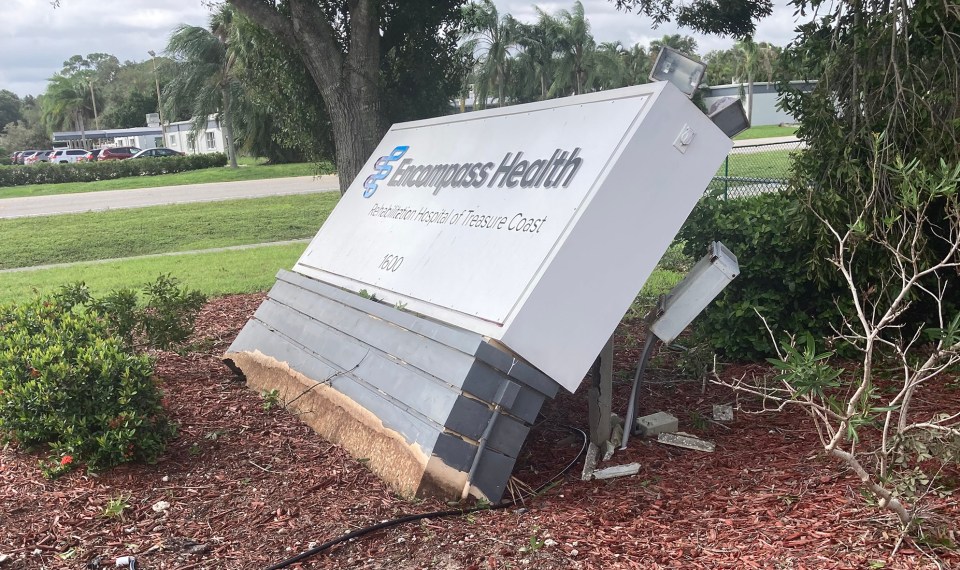Vision is an important sense everyone needs in order to participate in everyday activities. However, after a stroke, many experience a loss of vision, making activities such as dressing, bathing, cooking and cleaning challenging.
Those individuals could benefit from the interdiciplinary team approach provided in an inpatient rehabilitation setting. Occupational therapists (OTs) are a vital member of the care team in this setting, and they can also play a vital role in vision rehabilitation.
Occupational therapy’s objective in vision rehabilitation is to help the patient regain or compensate for visual impairments caused by their injury or illness. By developing comprehensive treatment plans that include environmental modifications, assistive technology, visual skills training and other multicomponent interventions, occupational therapists can help individuals with post-stroke vision loss return to their daily activities and their communities.
Understanding How Stroke Impacts Vision
Due to the interruption of blood supply to the brain after a stroke, individuals could experience visual deficits depending on the location and extent of their stroke. These may include, but are not limited to:
- Visual field loss. Visual field loss, or hemianopsia, is partial or complete loss of vision. It can occur in different patterns, such as homonymous hemianopsia, which is partial or complete loss of vision on the same side in both eyes, and quadrantanopsia, the loss of vision in one quadrant of the visual field. Visual field loss can affect a person’s ability to navigate their environment, locate objects, read, drive or engage in social activities.
- Visual neglect. Visual neglect is a condition in which individuals fail to attend to visual stimuli on one side, typically the side opposite of where the stroke occured. Individuals experiencing visual neglect may neglect objects in the visual field or may neglect one side of their body. Visual neglect can impair a person’s ability to perform self-care tasks, to navigate their environment, and read and write. It could also impact their safety awareness.
- Oculomotor dysfunction. Stroke can affect the coordination and control of eye movements, resulting in oculomotor dysfunction. This can make it difficult to perform smooth pursuits, saccades and fixation and result in deficits in visual scanning, reading and depth perception. Patients often experience visual fatigue and headaches due to oculomotor dysfunction.
- Visual processing deficits. Visual processing deficits refer to difficulties in perceiving and interpreting visual information. They can present as challenges in visual discrimination, spatial relationships, visual memory, figure-ground discrimination and motor integration.
- Diplopia. Also known as double vision, diplopia can occur when there is an injury to the nerves or muscles that control eye movement, making it difficult for the eyes to work together. Diplopia can cause deficits in depth perception and overall visual clarity.
- Visual-perceptual deficits. Visual perceptual deficits refer to the difficulty of processing and interpreting visual information. This can lead to trouble with remembering visual details, recognizing and discriminating between objects and understanding spatial relationships.
Visual Deficits and ADLs
It is important to observe how the patient’s visual deficits impact their performance in activities of daily living (ADL). Doing so can help assist in identifying their visual search deficiencies.
Patient education is also vital in order to provide them with insight into their deficits. The effectiveness of interventions can be measured by the patient’s level of awareness of their current deficits.
To assist them in better understanding their vision deficits, have the patient perform a visual search test. This will help them identify their current visual search pattern and understand how their visual search and attention has changed.
Have the patient retake the test; if their performance improves based on a better understanding of their deficit, it’s a good indication that they could benefit from therapy interventions.
Occupational therapy in an inpatient rehabilitation setting uses two primary approaches in treating visual deficits after a stroke: remediation and compensatory.
Remediation Approach
When occupational therapists use a remediation approach, the intervention is intended to establish or restore the patient’s ability to complete visual processing by improving aspects of visual performance. Key concepts of the remediation approach are:
- Establish an effective search strategy. Have the patient work on a left-to-right linear pattern and left-to-right clockwise or counter-clockwise visual search pattern. Begin a visual search strategy in the blind field, working towards the intact field. Utilize a wide head turn toward the blind field. Increase the number of head and eye movements toward the blind field. Promote patient attention to visual detail in the blind field. Facilitate their ability to shift attention and search from the central to the peripheral visual field on the blind side.
- Reinforce the visual search strategy with games such as Concentration or checkers.
- Place any commonly used items on the side with poor vision to facilitate visual scanning to that side.
- Provide sensory cues like bells, increased lighting and touch cues on the side of the blind field to promote the patient’s visual attention and visual scanning to the affected field.
- Use visual scanning worksheets (i.e., cancellation task, word search, line bisection, bells test).
- Utilize computer software designed for remediation of visual skills after a stroke. (i.e., BITS, Dynavision).
- Work on increasing the speed and accuracy of the eye movements.
Compensatory Approach
When using a compensatory approach, focus on adjusting the context of the environment or task to allow the patient to use their existing level of visual processing. Key concepts when utilizing the compensatory approach include:
- Ensure the patient is aware of their deficits.
- Place necessary items for a task in their visual field.
- Educate the patient and family on how the visual field loss will affect function and safety during daily living tasks.
- Utilize anchoring techniques during reading tasks.
- Add color or contrast to door frames, furniture and thresholds/steps. Remove area rugs.
Assistive Devices for Vision Deficits
There are a variety of assistive devices that can be used to facilitate independence for those with vision deficits post-stroke.
Occupational therapy’s role in recommending assistive devices, adaptations and modifications requires assessing the individual’s occupational performance deficits and financial, environmental and social contexts to ensure appropriate recommendations are made.
An in-depth task and activity analysis could help ensure independence carries over after discharge.
Referral to an occupational therapist who has a Specialty Certification in Low Vision (SCLV) or Assistive Technology Professional (ATP) could be warranted for further assessment and intervention after they leave the inpatient setting.
Technologies Used
The following low- to hi-tech adaptive equipment only captures a small portion of options that occupational therapists can use.
Low-Tech Options
- Bright duct tape. Tape step edges and door frames with bright duct tape to help make mobility in the home safer.
- Handheld magnifier. Make difficult to see objects such as menus and newspapers large for easier reading. Many handheld magnifiers come with lighting options for increased sight capabilities.
- Large print. Make commonly used household items easier to see with large printed digital or analog clocks, calendars and playing cards.
- Labeling. Labels with large print can make accessing items in cabinets, pantries and other rooms easier.
- Lighting. Illuminate hallways, stairways and commonly used rooms with LED lights or automatic lights to always have a well-lit home environment.
High-Tech Options
- Smart phone. Accessibility settings such as enlarged text and display, text-to-speech, voice control, apps and flashing lights for alerts are only a few options to ease phone use and social participation.
- Smart home devices. Smart home devices such as smart blinds, lights and plugs can be automated or activated by voice to improve independence, safety and engagement with ADL and iADL tasks.
- Smart speakers. Amazon, Google and Apple have smart speakers that can assist with controlling smart home devices and can also provide updates on the daily news with a voice command.
Visual Deficits and the Caregiver
Visual deficits post-stroke can significantly impact not only a patient’s quality of life, but also their caregiver’s.
The impact of visual deficits post-stroke is clear with issues related to driving, activities of daily living and social engagement. Patients and caregivers may wonder if their or their loved one’s visual deficits will improve to the point of not relying on compensatory strategies, and if they will be able to return to occupations such as community mobility and driving.
Some patients will, but many will continue to require interdisciplinary rehabilitation and intervention.
This translates to the need for purposeful patient and caregiver education early in their treatment.
In a study conducted in 2018, researchers found that caregiver education programs, specifically for patients recovering from stroke, had a positive outcome on the patients’ functional improvement and the caregiver’s satisfaction. Involving patients and their caregivers early in their post-stroke recovery can provide significant changes in the outlook of their quality of life and carryover of learned strategies when they move to the next setting of care or return to their communities.
Encompass Health occupational therapists Tarah O’Shea, Tara Allen, Kathryn Dozier, Tracy Skinner, Christa Layou, Theresa Pham and Jamie Chapman contributed to this research and post.
Resources
- Vision Therapy for Post-Concussion Vision Disorders (2016)
- A Discussion and Analysis, in the context of current research to May 2016, of: A critical evaluation of the evidence supporting the practice of behavioural vision therapy
- visiontherapy.org/vision-therapy/vision-therapy-studies.html
- https://www.bouldervt.com/vision-library/vision-therapy/
- nora.cc/
- ebrsr.com/
- org/searchable_databases
- eyecanlearn.com/
- edhelper.com/visual_skills.htm
- www.vision3d.com/
- https://www.optometrists.org/vision-therapy/
- Green, M., Barstow, B., & Vogtle, L. (2018). Lighting as a compensatory strategy for acquired visual deficits after stroke: Two case reports. The American Journal of Occupational Therapy, 72(2), 7202210010p1-7202210010p6. https://doi.org/10.5014/ajot.2018.023382
- Hunter, E. G., & Rhodus, E. (2022). Interventions within the scope of occupational therapy to address preventable adverse events in inpatient and home health postacute care settings: A systematic review. American Journal of Occupational Therapy, 76, 7601180060. https://doi.org/10.5014/ ajot.2022.047589
- Hepworth L., & Rowe F. J. (2016). Visual impairment following stroke – the impact on quality of life: a systematic review. Ophthalmology Research: An International Journal, 5(2), 1–15.
- Hong, S. E., Kim, C. H., Kim, E. J., Joa, K. L., Kim, T. H., Kim, S. K., Han, H. J., Lee, E. C., & Jung, H. Y. (2017). Effect of a Caregiver’s Education Program on Stroke Rehabilitation. Annals of rehabilitation medicine, 41(1), 16–24.
- Novario, G., Fairman, A., Morris, L., & Ding, D. (2021, September). Harnessing the potential of smart home technology. OT Practice, 26(9), 10-13.
- Pendleton, H. M., & Schultz-Krohn, W. (2013). Pedretti’s occupational therapy: Practice skills for physical dysfunction (7th ed.). Elsevier.
- Smallfield, S., & Kaldenberg, J. (2019). Occupational therapy interventions to improve reading performance of older adults with low vision: A systematic review. The American Journal of Occupational Therapy, 74 (1): 7401185030p1-7401185030p18.
- Zoltan, B. (2007). Vision, perception, and cognition: A manual for the evaluation and treatment of the adult with acquired brain injury (4th ed.). Slack.
The content of this site is for informational purposes only and should not be taken as professional medical advice. Always seek the advice of your physician or other qualified healthcare provider with any questions you may have regarding any medical conditions or treatments.



